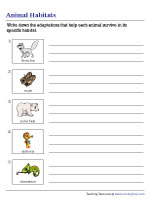Animal Habitats Worksheets
- Science >
- Animal Habitats
Observe animals in their natural surroundings using our free animal habitats worksheets. Be it forests, grasslands, deserts, oceans, or polar regions, every habitat gets its time to shine in this series. Explore in depth the layers of rainforests, the adaptations that help animals survive, and the link between humans and biodiversity, among other exciting tasks.
These animal habitats worksheets are designed for kindergarten through grade 5 learners.
Neatly labeled pictures are the best way for children to identify the habitats of animals. Utilize these printable animal habitat flashcards and acquaint them with mountains, deserts, forests, and more.
Packed with loads of fun and flavor, this eclectic assortment will have kindergarten and grade 1 kids eager to learn about animal homes, such as stables, pigsties, kennels, and more.
Sorting Animals Based on Habitats
The majestic lion lives its best life in the grasslands, whereas the glorious tiger makes it way stealthily across a forest. Sort the animals and glue their pictures under the correct habitats.
Penguins flourish in oceans and coasts, raccoons adore marshes, and camels belong in deserts. Remember these facts and match the animals with the habitats they thrive in.
The greenery of the grassland gives it away, as does the deep blue color of the ocean. Pick up such interesting visual hints and label the pictures of the different animal habitats here.
Ages and ages of gradual genetic changes have resulted in animals developing specialized adaptations to suit their environments. Figure out the adaptations these animals flaunt.
Identifying Animals in Specified Habitats
Bear in mind that you can circle more than one option for each set of animal pictures. Direct kids to circle all the animals that live in the tundra, grasslands, forests, and oceans.
Recognizing Habitats of Animals
A delectable treat for the budding biologists in grade 2 and grade 3, this pdf features the straightforward, yet effective, task of choosing the habitat each animal inhabits.
Matching Animals to Adaptations
With animals taking up one half of this worksheet, their adaptations take up the other. Match the moth to its cryptic coloration, the cheetah to its speed and agility, and so on.
Completing Statements on Aquatic Habitats
The azure depths of the ocean share the stage with the crystal clear waters of rivers and lakes in this section. Fill in the blanks to complete sentences on aquatic habitats.
Statements on Polar Habitats | True of False
The dazzling expanse of the polar regions are front and center in this part of our animal habitats worksheets. Discern factually correct statements and write T or F as appropriate.
The dark and damp forest floor lies below the ever-so-slightly illuminated understory, which in turn lies below the canopy. Explore the lush green rainforest in this printable exercise.
Animals and Plants in Rainforest Layers
Ferns and orchids are plentiful on the forest floor, while toucans and howler monkeys are at home in the canopy. Grade 4 and grade 5 kids write the names of animals and plants found in different layers.
Migration patterns certainly deserve a spot in our worksheets on animal habitats, as proven by this segment, where children answer questions based on migrational information.
Enter a world of colorful coral reefs and lush seagrass beds in this exercise, where 2nd grade and 3rd grade kids are tasked with matching ocean ecosystems to definitions and examples.
Sorting Terrestrial and Aquatic Animals
Darken the divide between land animals and water animals with this worksheet, featuring a sorting activity based on whether animals belong in aquatic or terrestrial habitats.
Animal Adaptations in Desert Habitats
Watch how these animals battle the scorching heat and sparse vegetation characteristic of desert habitats. Read questions about their adaptations and check the correct options.
Living Together: Humans and Biodiversity
Enhance environmental awareness in 4th grade and 5th grade kids with this animal habitats worksheet. Answer questions based on the passage about humans and biodiversity.



















